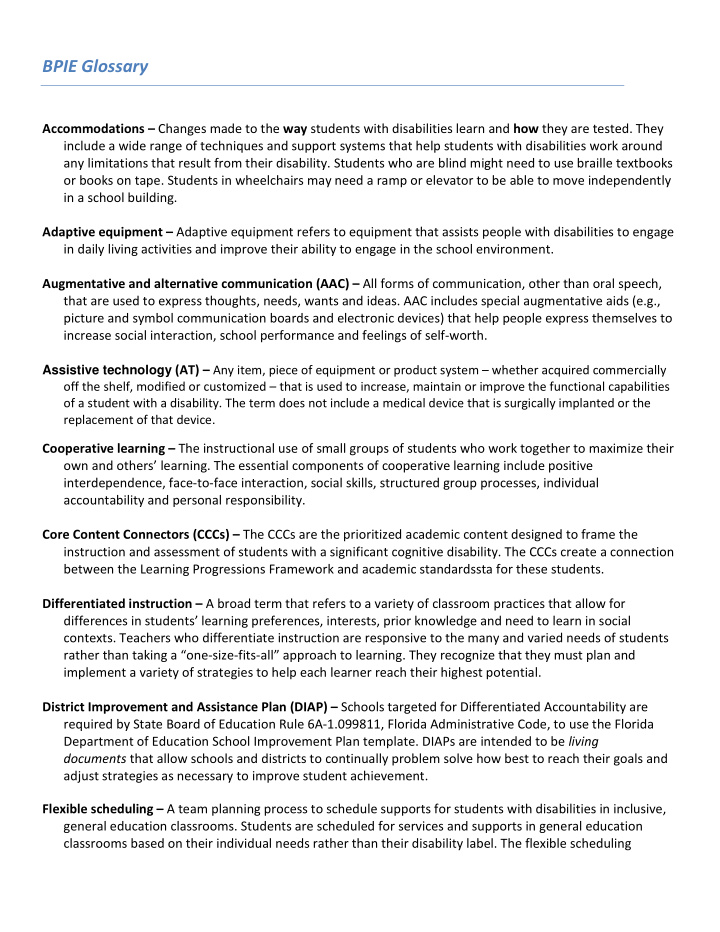



BPIE Glossary Accommodations – Changes made to the way students with disabilities learn and how they are tested. They include a wide range of techniques and support systems that help students with disabilities work around any limitations that result from their disability. Students who are blind might need to use braille textbooks or books on tape. Students in wheelchairs may need a ramp or elevator to be able to move independently in a school building. Adaptive equipment – Adaptive equipment refers to equipment that assists people with disabilities to engage in daily living activities and improve their ability to engage in the school environment. Augmentative and alternative communication (AAC) – All forms of communication, other than oral speech, that are used to express thoughts, needs, wants and ideas. AAC includes special augmentative aids (e.g., picture and symbol communication boards and electronic devices) that help people express themselves to increase social interaction, school performance and feelings of self-worth. Assistive technology (AT) – Any item, piece of equipment or product system – whether acquired commercially off the shelf, modified or customized – that is used to increase, maintain or improve the functional capabilities of a student with a disability. The term does not include a medical device that is surgically implanted or the replacement of that device. Cooperative learning – The instructional use of small groups of students who work together to maximize their own and others’ learning. The essential components of cooperative learning include positive interdependence, face-to-face interaction, social skills, structured group processes, individual accountability and personal responsibility. Core Content Connectors (CCCs) – The CCCs are the prioritized academic content designed to frame the instruction and assessment of students with a significant cognitive disability. The CCCs create a connection between the Learning Progressions Framework and academic standardssta for these students. Differentiated instruction – A broad term that refers to a variety of classroom practices that allow for differences in students’ learning preferences, interests, prior knowledge and need to learn in social contexts. Teachers who differentiate instruction are responsive to the many and varied needs of students rather than taking a “one-size-fits-all” approach to learning. They recognize that they must plan and implement a variety of strategies to help each learner reach their highest potential. District Improvement and Assistance Plan (DIAP) – Schools targeted for Differentiated Accountability are required by State Board of Education Rule 6A-1.099811, Florida Administrative Code, to use the Florida Department of Education School Improvement Plan template. DIAPs are intended to be living documents that allow schools and districts to continually problem solve how best to reach their goals and adjust strategies as necessary to improve student achievement. Flexible scheduling – A team planning process to schedule supports for students with disabilities in inclusive, general education classrooms. Students are scheduled for services and supports in general education classrooms based on their individual needs rather than their disability label. The flexible scheduling
process results in teacher master schedules that allow services to be provided where and when supports are needed. Functional behavioral assessment (FBA) – The purpose of an FBA is to identify the function or purpose of an individual’s inappropriate behavior by examining the environment in which the behavior is occurring and identifying the variables that maintain the behavior. General education and natural contexts – All physical settings frequented by students without disabilities and the people and naturally occurring activities taking place in those settings, to include the following: • Natural school settings (e.g., classrooms, cafeteria, football stadium, common areas) • Community-based settings • Roles and contributions of the participants in natural settings • Interpersonal relationships among the participants in natural settings High incidence disabilities– Students with the most commonly-occurring disabilities, such as a communication disorder (speech and language impairment), specific learning disability, mild/moderate cognitive disability, or an emotional or behavioral disorder. Inclusion (as defined in § 1003.57, Florida Statutes [F.S.]) – A student with a disability receiving education in a general education regular class setting, reflecting natural proportions and age-appropriate heterogeneous groups in core academic and elective or special areas within the school community; a student with a disability is a valued member of the classroom and school community; the teachers and administrators support universal education and have knowledge and support available to enable them to effectively teach all children; and a student is provided access to technical assistance in best practices, instructional methods, and supports tailored to the student’s needs based on current research. Least restrictive environment – The IDEA entitles all students with disabilities to a free, appropriate education in the least restrictive environment. This means that, to the maximum extent possible, children with disabilities are to be educated with children who are not disabled. Special classes, separate schooling or other ways of removing children with disabilities from the regular educational environment should only occur when the nature or severity of the disability is such that education in regular classes cannot be achieved satisfactorily with the use of supplementary aids and services. Low incidence disabilities– Students with a particular disability or combination of disabilities, such as blindness, low vision, deafness, hard-of-hearing, dual sensory impairment, significant cognitive disability, complex health issues, serious physical impairment, multiple disability, traumatic brain injury, and autism spectrum disorder, that generally do not exceed 1% of the school population. Modifications – Changes made to what students with disabilities are expected to learn. Students who are not able to work on grade level or pass the required courses for a standard diploma may need a modified curriculum to meet their priority educational goals. Generally, these students will be working toward completion of a special diploma upon graduation. Multi-tiered system of support (MTSS) – MTSS uses a data-based, problem-solving process that matches the intensity of support with student needs to most efficiently allocate resources to improve learning and behavior for all students. Effective core instruction and interventions are provided for all students, including students with disabilities, who need various levels of supports to master all academic standards.
Recommend
More recommend